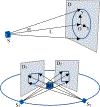Using temporal and structural data to reconstruct 3D cerebral vasculature from a pair of 2D digital subtraction angiography sequences
- PMID: 35636377
- PMCID: PMC10801782
- DOI: 10.1016/j.compmedimag.2022.102076
Using temporal and structural data to reconstruct 3D cerebral vasculature from a pair of 2D digital subtraction angiography sequences
Abstract
Purpose: The purpose of this work is to present a new method for reconstructing patient-specific three-dimensional (3D) vasculature of the brain from a pair of digital subtraction angiography (DSA) image sequences from different viewpoints, e.g., from bi-plane angiography. Our long-term goal is to provide high resolution visualization of 3D vasculature with dynamic flow of contrast agent from limited data that is readily available during surgical procedures. The proposed method is the second of a three-stage process composed of 1) augmenting vessel segmentation with vessel radii and timing of the arrival of a bolus of contrast agent, 2) reconstructing a volumetric representation of the augmented vessel data from the augmented 2D segmentations, and 3) generating a 3D model of vessels and flow of contrast agent from the volumetric reconstruction. Unlike previous methods, which are either limited to relatively simple vessel structures or rely on multiple views and/or prior models of the vasculature, our method requires only a single pair of 2D DSA sequences taken from different view directions.
Methods: We developed a new mathematical algorithm that augments vessel centerlines with vessel radii and bolus arrival times derived directly from the 2D DSA sequences to constrain the 3D reconstruction. We validated this method on digital phantoms derived from clinical data and from fractal models of branching tree structures.
Results: In standard reconstruction methods, reconstruction by projection of two views into 3D space results in 'ghosting' artifacts, i.e., false 3D structure that occurs where vessels or vessel segments overlap in the 2D images. For the complex vascular of the brain, this ghosting is severe and is a major hurdle for methods that attempt to generate 3D structure from 2D images. We show that our approach reduces ghosting by up to 99% in digital phantoms derived from clinical data.
Conclusion: Our dramatic reduction in ghosting artifacts in 3D reconstructions from a pair of 2D image sequences is an important step towards generating high resolution 3D vasculature with dynamic flow information from a single DSA sequence acquired using bi-plane angiography.
Keywords: 3D reconstruction; Brain blood vessels; Cerebral vasculature; Digital subtraction angiography.
Copyright © 2022 Elsevier Ltd. All rights reserved.
Figures










Similar articles
-
Spatiotemporally constrained 3D reconstruction from biplanar digital subtraction angiography.Int J Comput Assist Radiol Surg. 2025 Aug;20(8):1689-1701. doi: 10.1007/s11548-025-03427-9. Epub 2025 Jun 1. Int J Comput Assist Radiol Surg. 2025. PMID: 40450607 Free PMC article.
-
A 2D driven 3D vessel segmentation algorithm for 3D digital subtraction angiography data.Phys Med Biol. 2011 Oct 7;56(19):6401-19. doi: 10.1088/0031-9155/56/19/015. Epub 2011 Sep 9. Phys Med Biol. 2011. PMID: 21908904
-
Reconstruction of blood propagation in three-dimensional rotational X-ray angiography (3D-RA).Comput Med Imaging Graph. 2005 Oct;29(7):507-20. doi: 10.1016/j.compmedimag.2005.03.006. Epub 2005 Sep 2. Comput Med Imaging Graph. 2005. PMID: 16140501
-
MR angiography with three-dimensional MR digital subtraction angiography.Top Magn Reson Imaging. 1996 Dec;8(6):366-88. Top Magn Reson Imaging. 1996. PMID: 9402678 Review.
-
4D-DSA: Development and Current Neurovascular Applications.AJNR Am J Neuroradiol. 2021 Jan;42(2):214-220. doi: 10.3174/ajnr.A6860. Epub 2020 Nov 26. AJNR Am J Neuroradiol. 2021. PMID: 33243899 Free PMC article. Review.
Cited by
-
Spatiotemporally constrained 3D reconstruction from biplanar digital subtraction angiography.Int J Comput Assist Radiol Surg. 2025 Aug;20(8):1689-1701. doi: 10.1007/s11548-025-03427-9. Epub 2025 Jun 1. Int J Comput Assist Radiol Surg. 2025. PMID: 40450607 Free PMC article.
-
Entrapment of microguidewire into perforator during endovascular treatment: Case report and management strategy.J Int Med Res. 2025 Aug;53(8):3000605251370336. doi: 10.1177/03000605251370336. Epub 2025 Aug 29. J Int Med Res. 2025. PMID: 40882963 Free PMC article.
-
Semi-automatic segmentation of elongated interventional instruments for online calibration of C-arm imaging system.Int J Comput Assist Radiol Surg. 2025 Jun 26. doi: 10.1007/s11548-025-03434-w. Online ahead of print. Int J Comput Assist Radiol Surg. 2025. PMID: 40569316
-
In-Silico Investigation of 3D Quantitative Angiography for Internal Carotid Aneurysms Using Biplane Imaging and 3D Vascular Geometry Constraints.ArXiv [Preprint]. 2025 Feb 13:arXiv:2502.09694v1. ArXiv. 2025. PMID: 39990793 Free PMC article. Preprint.
-
Spatiotemporal Disentanglement of Arteriovenous Malformations in Digital Subtraction Angiography.Proc SPIE Int Soc Opt Eng. 2024 Feb;12926:129263B. doi: 10.1117/12.3006740. Epub 2024 Apr 2. Proc SPIE Int Soc Opt Eng. 2024. PMID: 39156762 Free PMC article.
References
-
- Benes V, Bradáč O, 2017. Brain Arteriovenous Malformations : Pathogenesis, Epidemiology, Diagnosis, Treatment and Outcome. Springer, Cham, SWITZERLAND.
-
- Berthilsson R, Astrom K, 1997. Reconstruction of 3D-curves from 2D-images using affine shape methods for curves, Proceedings of IEEE Computer Society Conference on Computer Vision and Pattern Recognition, pp. 476–481.
-
- Blondel C, Vaillant R, Malandain G, Ayache N, 2004. 3D tomographic reconstruction of coronary arteries using a precomputed 4D motion field. Phys Med Biol 49, 2197–2208. - PubMed
-
- Bullitt E, Liu A, Pizer SM, 1997. Three-dimensional reconstruction of curves from pairs of projection views in the presence of error. I. Algorithms. Med Phys 24, 1671–1678. - PubMed
-
- Cai Y, Su Z, Li Z, Sun R, Liu X, Zhao Y, 2011. Two-view curve reconstruction based on the snake model. Journal of Computational and Applied Mathematics 236, 631–639.
Publication types
MeSH terms
Substances
Grants and funding
LinkOut - more resources
Full Text Sources
Medical

